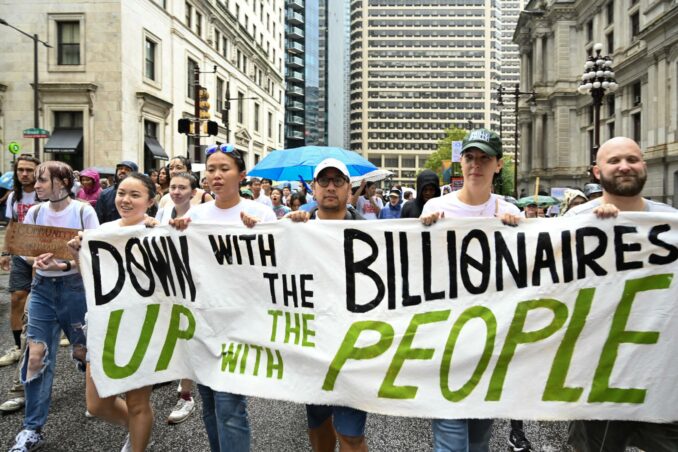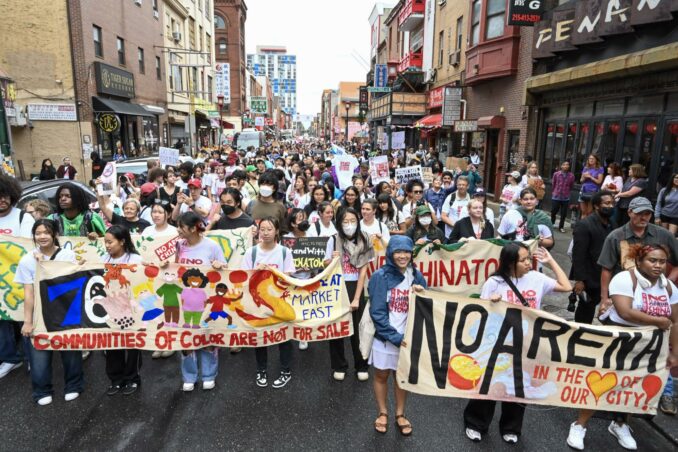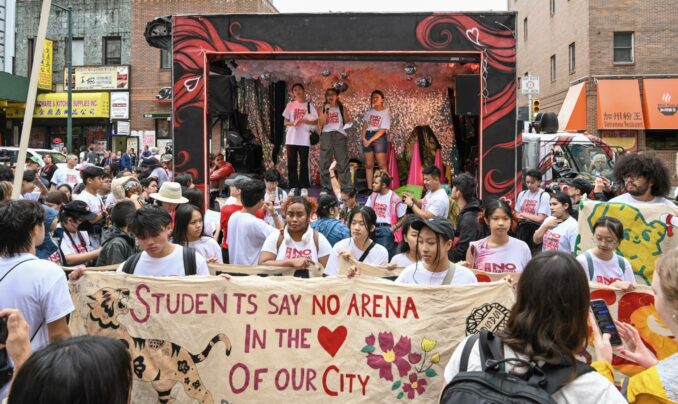The people vs. the billionaires
Philadelphia
Several thousand people turned out for the Save Chinatown Coalition rally on Sept. 7 to protest the Philadelphia 76ers’ proposal to build a new $1.55 billion arena near Chinatown called “76 Place.” While the National Basketball Association team’s billionaire owners repeatedly say a new arena at 10th and Market streets would provide “economic opportunity for surrounding areas,” community residents, who have been fighting this proposal for over two years, argue that it would be an “existential threat” to this historic Philadelphia neighborhood.

March against proposed Sixers basketball arena, Philadelphia, Sept. 7, 2024. (WW Photo: Joe Piette)
The impact studies commissioned by the city, released in late August, support the residents’ arguments. The studies said the development “could potentially result in the loss of Chinatown’s core identity and regional significance.” (Philadelphia Inquirer, Aug. 26)
Opposition to the proposed arena extends beyond Chinatown residents, as reflected by the turnout and the speakers at the rally, many who see this as yet more billionaire gentrifiers’ efforts to profit from the destabilization of Philadelphia’s Center City’s last community of color.
Many arena opponents are concerned that the facility will cause congestion, displacement of businesses and residents, as well as increasing the gentrification that has already devastated many historic Black and Brown Philadelphia communities.
Maximizing profits at the expense of people’s welfare
The opening rally, held outside Philadelphia City Hall, began with an address by Wendsler Nosie Sr. who is with the Indigenous Apache Stronghold. The group was traveling from Arizona to Washington, D.C., for a fight in federal court to stop a mining operation’s land grab.
Several speakers denounced the billionaire developers who have gentrified the other neighborhoods, putting their drive for profits ahead of the needs of community residents – and the politicians who have supported the gentrifiers with taxpayers’ money while public needs go unmet.

March against proposed arena, Philadelphia, Sept. 7, 2024. (WW Photo: Joe Piette)
Melvin Hairston, former University City Townhomes resident, said that Chinatown’s fight against the arena should matter to all Philadelphians concerned about gentrification and displacement. Hairston was one of the residents of 69 units of low-income affordable housing near the University of Pennsylvania that were demolished in late 2023 after a prolonged struggle by this predominantly Black and Brown community against eviction. He said gentrification “affects all of us in every way, shape or form. That’s why everybody needs to be involved.” Visit workers.org/2022/09/66873/ for more on the UC Townhomes struggle.
State Reps. Rick Krajewski and Chris Rabb and State Sen. Nikil Saval all spoke against the arena proposal, as did City Councilmember Nicholas O’Rourke, the sole councilmember to attend. The final decision on the arena is being left to Philadelphia City Council members who will debate the proposal this fall.
Youth lead the struggle
As demonstrators were preparing to start their march through Center City to Chinatown, the skies opened up with torrential rain that did nothing to dampen their enthusiasm. Rally organizers provided three golf carts to give rides for people with disabilities who might not otherwise participate in the march, including this reporter. Throughout the event, interpreters translated speeches into Mandarin.
Chinatown residents have been fighting for their community’s survival since it was established in 1871. They were unable to prevent construction of the Vine Street expressway that divided the community, construction of a nearby federal prison and the expansion of the convention center that have impacted their neighborhoods. However, over recent decades, they have successfully stopped plans to build a baseball stadium and a casino in Chinatown.
The clear majority of march participants were young Asians, many who have grown up watching their parents and grandparents engage in these earlier struggles against efforts to destroy Chinatown.

Youth speak out against the arena, Philadelphia, Sept. 7, 2024. (WW Photo: Joe Piette)
A contingent of young speakers from Students for the Preservation of Chinatown opened up the second rally at the Friendship Arch following the march. Speaking collectively, these young activists asked why the billions of dollars that the city is considering for the arena should not go instead for air conditioning and libraries in public schools and playgrounds in the many city neighborhoods that have none.
Speakers at the closing rally included a medical student who addressed concerns that the arena would impact traffic to and from the nearby Jefferson hospital complex. Residents of Washington Square West and the Gayborhood, a historic LGBTQIA2S+ area, which would also be impacted, condemned the arena proposal. A speaker from the immigrant/migrants’ rights group Juntos compared this proposed gentrification to the globalization that has forced millions of South and Central American and Caribbean people to leave their countries.
Low-wage jobs with no benefits
In pitching the arena construction and in an effort to divide Philadelphia’s diverse communities, the wealthy Sixers’ owners appealed to some Black organizations for support with promises of jobs. One of the final speakers at the rally noted that Aramark, which runs the food concession stands at the sports arenas that house the four Philadelphia major league sports teams, pays their workers around $12 per hour and offers few benefits.
Fed up with working for low wages and minimum benefits, over 80% of Aramark food service workers, represented by UNITE HERE Local 274, have voted to authorize strikes at all local sports venues.

